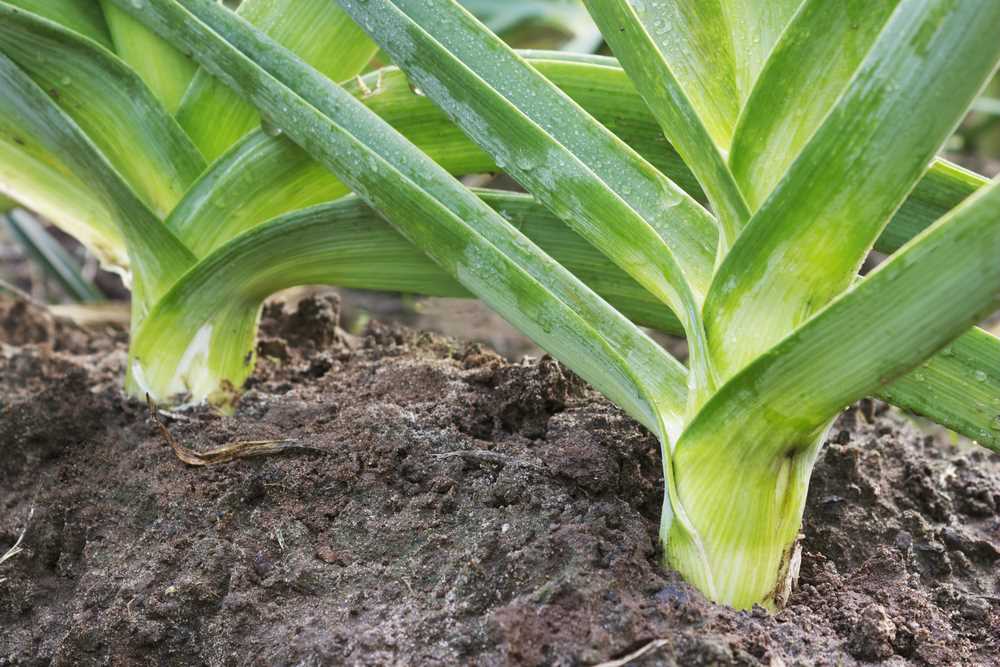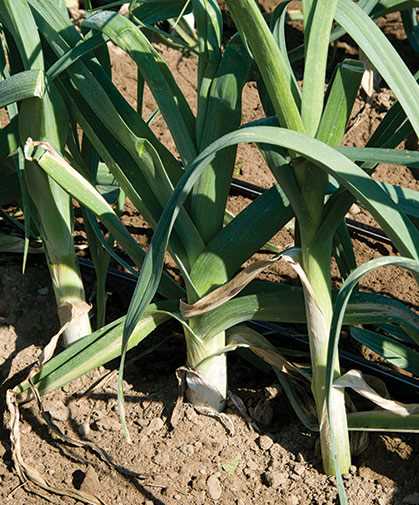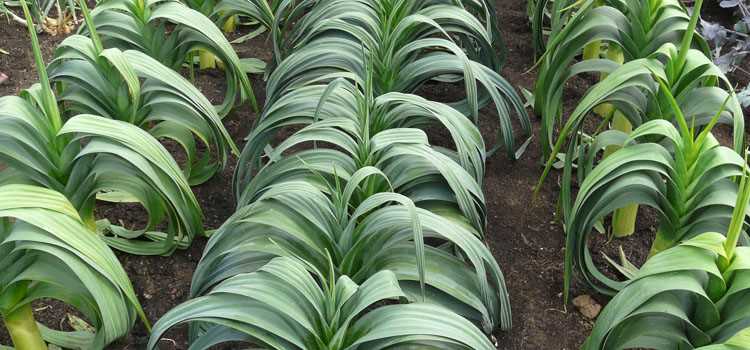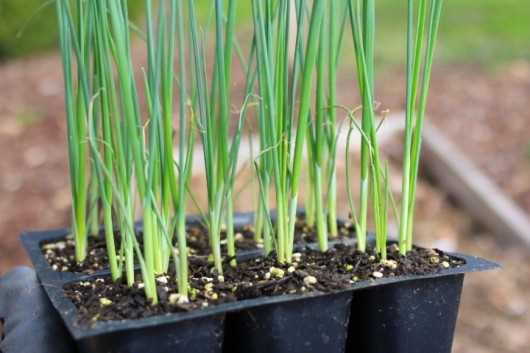- Why grow leeks in your vegetable garden?
- Choosing the right variety of leeks
- 1. Days to maturity
- 2. Size and shape
- 3. Cold tolerance
- 4. Disease resistance
- 5. Flavor and culinary uses
- When and where to sow leek seeds
- Outdoor sowing
- Indoor sowing
- Preparing the soil for leeks
- 1. Choose a sunny location
- 2. Test the soil
- 3. Improve the soil structure
- 4. Remove weeds and debris
- 5. Add fertilizer
- 6. Create trenches or raised beds
- 7. Water the soil
- 8. Mulch the soil
- Planting leek seedlings
- Caring for growing leeks
- Watering
- Fertilizing
- Weeding
- Hilling
- Thinning
- Pest and disease control
- Harvesting
- Harvesting and Storing Leeks
- Common problems and pests affecting leeks
- Fungal diseases
- Insect pests
- Weeds
- Question-answer:
- What are the benefits of growing leeks in your vegetable garden?
- What is the best time of year to start growing leeks from seeds?
- Can leeks be grown in containers?
- How often should leeks be watered?
- How long does it take for leeks to mature from seeds?
- Video: 5 Must-Grow Perennial Vegetables: Harvest Year After Year…
Leeks, with their mild and onion-like flavor, are a versatile vegetable that can be used in a variety of dishes. Growing leeks in your own vegetable garden is a rewarding experience that allows you to enjoy these flavorful greens straight from your backyard. While it may seem daunting to start growing leeks from seeds, with the right techniques and a little patience, you can have a bountiful harvest of leeks in no time.
Choosing the right variety of leeks is the first step in growing leeks from seeds. There are different types of leeks available, each with their own unique characteristics. Some varieties are better suited for early harvesting, while others are more cold-hardy. Consider the climate and growing conditions in your area before selecting a variety to ensure the best chance of success.
Starting leek seeds indoors is the recommended method, as it gives the seeds a head start before being transplanted outdoors. Leek seeds can be sown 8-10 weeks before the expected last frost date in your area. Fill a seed tray or small pots with seed starting mix and sow the seeds about 1/4 inch deep. Keep the soil moist, and provide adequate warmth and light for germination.
Why grow leeks in your vegetable garden?
Growing leeks in your vegetable garden has numerous benefits. These versatile vegetables are not only delicious and nutritious, but they also add beauty and variety to your garden. Here are some reasons why you should consider growing leeks:
- Health benefits: Leeks are packed with nutrients, including vitamins A, C, and K, as well as minerals like iron and manganese. They also contain antioxidants and fiber, which are important for a healthy diet.
- Flavorful addition to meals: Leeks have a mild and sweet onion-like flavor that adds depth and complexity to a wide range of dishes. They can be used in soups, stews, stir-fries, and more, and can be enjoyed both cooked and raw.
- Easy to grow: Leeks are relatively low-maintenance plants that can be grown from seeds. They are quite hardy and can tolerate a range of growing conditions, making them suitable for beginner and experienced gardeners alike.
- Long harvest period: Leeks have a long growing season, which means you can enjoy a bountiful harvest over an extended period. They can be harvested from late summer through to winter, providing you with fresh produce even in colder months.
- Attractive in the garden: Leeks have tall, slender stalks and beautiful green leaves, adding texture and visual interest to your vegetable garden. They can make an attractive border or be used as a decorative element in flower beds.
- Storage and preservation: Leeks have a good shelf life and can be stored for several weeks in a cool, dry place. They can also be preserved by blanching and freezing, allowing you to enjoy their flavor and nutritional benefits year-round.
- Companion planting: Leeks are known to be good companion plants for many vegetables, including carrots, tomatoes, and peas. They can help repel pests and attract beneficial insects, promoting overall garden health.
- Sustainable gardening: By growing leeks in your vegetable garden, you can reduce your carbon footprint by eliminating the need to buy them from the store. Additionally, you have control over the growing process, ensuring that no harmful chemicals or pesticides are used.
Overall, growing leeks in your vegetable garden can provide you with a versatile, nutritious, and flavorful addition to your meals. Whether you are a seasoned gardener or just starting out, these plants are a great choice for a successful and rewarding gardening experience.
Choosing the right variety of leeks
When deciding to grow leeks in your vegetable garden, it’s important to choose the right variety of leeks that suits your needs and growing conditions. Here are some factors to consider when selecting leek varieties:
1. Days to maturity

The first thing to look at is the number of days to maturity. This refers to the time it takes for the leeks to grow and be ready for harvest. Different varieties have different maturity periods, ranging from 60 to 180 days. Choose a variety that aligns with your desired harvesting timeline and the length of your growing season.
2. Size and shape
Leek varieties come in different sizes and shapes. Some varieties produce smaller, slender leeks, while others yield larger, more robust ones. Consider the space available in your garden and your preference for the size and shape of the leeks.
3. Cold tolerance
If you live in a region with cold winters, it’s important to select leek varieties that are cold-tolerant. These varieties can withstand freezing temperatures and continue to grow. Look for varieties that are labeled as cold-hardy or winter leeks.
4. Disease resistance
Leeks can be susceptible to certain diseases, such as rust or leek moth. To prevent and minimize the risk of disease, choose varieties that are known for their disease resistance. Check the seed packets or catalog descriptions for information on disease resistance.
5. Flavor and culinary uses
Lastly, consider the flavor and culinary uses of the leek varieties. Some varieties have a milder flavor, while others are more pungent. Think about how you plan to use the leeks in your cooking and choose a variety that suits your taste preferences.
By considering these factors, you can choose the right variety of leeks for your garden, ensuring a successful and satisfying harvest.
When and where to sow leek seeds
Leek seeds can be sown both outdoors and indoors, depending on your growing zone and preferences. Here are some guidelines on when and where to sow leek seeds:
Outdoor sowing
- In areas with a long growing season, leek seeds can be sown directly outdoors in early spring, as soon as the soil can be worked.
- Choose a sunny location in your vegetable garden that has well-drained soil.
- Prepare the soil by raking it to eliminate any clumps and remove debris.
- Make furrows in the soil about 1/2 inch deep and 1 foot apart.
- Sow the leek seeds thinly along the furrows, aiming for a spacing of about 6 inches between seeds.
- Cover the seeds lightly with soil and water gently to ensure good soil-to-seed contact.
- Thin the seedlings when they are around 2 inches tall, leaving the strongest plants about 6 inches apart.
Indoor sowing
- In areas with short growing seasons, it’s best to start leek seeds indoors 8-10 weeks before the last expected frost date.
- Fill seed trays or pots with a seed-starting mix, which provides good drainage.
- Sow the leek seeds thinly on the surface of the soil, gently pressing them into the mix.
- Water from the bottom to avoid dislodging the seeds.
- Cover the trays or pots with plastic wrap or a clear plastic dome to create a greenhouse effect and retain moisture.
- Place the trays or pots in a warm location with indirect sunlight or under fluorescent lights.
- Once the seedlings have emerged, remove the plastic wrap or dome and provide them with 12-14 hours of light per day.
- Transplant the seedlings outdoors when they are about 6 inches tall and the soil has warmed up.
By following these guidelines, you can ensure successful germination and healthy growth of leek seeds in your vegetable garden.
Preparing the soil for leeks
Preparing the soil properly is essential for successful leek growth. Here are some steps to follow:
1. Choose a sunny location
Leeks prefer full sun, so select a spot in your garden that receives at least 6-8 hours of direct sunlight each day.
2. Test the soil
It’s important to test the soil pH and fertility before planting leeks. Leeks prefer slightly acidic soil with a pH level between 6.0 and 7.0. You can use a soil testing kit to determine the pH of your soil.
3. Improve the soil structure
Leeks need loose, well-draining soil. If your soil is heavy and clay-like, you can improve its structure by adding organic matter such as compost, well-rotted manure, or peat moss. Mix the organic matter into the top 6-8 inches of soil using a garden fork or tiller.
4. Remove weeds and debris
Clear the area of any weeds, rocks, or debris that may inhibit leek growth. Weeds can compete with leeks for nutrients and water, so it’s important to remove them before planting.
5. Add fertilizer

Leeks are heavy feeders and require a nutrient-rich soil. Before planting, add a balanced fertilizer such as 10-10-10 or composted chicken manure. Follow the recommended application rate on the package for the size of your garden.
6. Create trenches or raised beds

Leeks have long, white stems, so it’s important to create trenches or raised beds to allow the stems to elongate. Dig a trench that is about 6-8 inches deep and 3-4 inches wide. Space the trenches about 12-18 inches apart to allow room for the leeks to grow.
7. Water the soil
Before planting the leek seeds or seedlings, thoroughly water the soil to ensure it is evenly moist. Leeks require consistent moisture throughout the growing season, so keep the soil consistently moist but not waterlogged.
8. Mulch the soil
After planting, apply a layer of organic mulch such as straw or wood chips around the leek plants. Mulch helps to retain soil moisture, suppress weeds, and regulate soil temperature.
By following these steps and preparing the soil properly, you can create an ideal growing environment for your leeks and increase your chances of a successful harvest.
Planting leek seedlings

Once your leek seedlings have reached a height of about 6 inches and have developed a strong root system, they are ready to be transplanted into your garden. Here are the steps you need to follow to plant your leek seedlings:
- Choose a sunny spot in your vegetable garden with well-drained soil. Leeks prefer a pH level of 6.0 to 7.0.
- Prepare the soil by removing any weeds and loosening it with a garden fork or shovel. This will help the leek seedlings establish their roots easily.
- Using a dibber or your finger, make holes in the soil that are about 6 inches deep and 6 inches apart. Space rows of leek seedlings about 12 inches apart.
- Carefully remove the leek seedlings from their containers, taking care not to damage the roots. Gently tease the roots apart if they are tangled.
- Place each leek seedling into a hole, making sure that the base of the stem is level with the soil surface. Do not bury the seedling too deep as this can cause the stem to rot.
- Backfill the holes with soil, firming it gently around the base of each seedling to ensure good soil-to-root contact.
- Water the seedlings thoroughly after planting to settle the soil around the roots. Leeks require consistent moisture, so make sure to keep the soil moist but not waterlogged.
It is important to note that leeks have a long growing season and require about 120-150 days to reach maturity. During this time, make sure to keep the soil moist, provide regular fertilizer application, and weed the garden bed regularly to reduce competition for nutrients.
By following these steps and providing proper care, you will be able to enjoy a bountiful harvest of delicious leeks from your vegetable garden.
Caring for growing leeks
Once you have successfully planted your leek seeds and they have germinated, it is important to provide the proper care for the seedlings to ensure a healthy and abundant crop. Here are some tips for caring for growing leeks:
Watering
Leeks require consistent moisture to promote healthy growth. Keep the soil evenly moist but not waterlogged. Water the plants deeply once or twice a week, depending on weather conditions. Avoid overhead watering to prevent the spread of diseases.
Fertilizing
Leeks are heavy feeders and benefit from regular fertilization. Before planting, amend the soil with compost or well-rotted manure to improve fertility. During the growing season, apply a balanced fertilizer every 4-6 weeks. Avoid excessive use of nitrogen-rich fertilizers, as it can result in lush leaf growth and smaller bulbs.
Weeding
Regular weeding is essential to prevent competition for nutrients and water. Keep the area around your leek plants free from weeds by hand pulling or using a hoe. Be careful not to disturb the shallow root system of the leeks while weeding.
Hilling
Leeks benefit from hilling, which is the process of piling soil around the base of the plant as it grows. This helps to blanch the stem and promotes longer white shanks. Begin hilling when the plants are about 6 inches tall, and repeat every few weeks until the soil reaches the base of the lowest leaves.
Thinning
If your leeks are overcrowded, they will not reach their full size. Thin the seedlings once they are about 6 inches tall, leaving space between each plant for proper growth. Use a pair of scissors to cut the excess seedlings at ground level, being careful not to disturb the remaining plants.
Pest and disease control
Monitor your leeks regularly for pests such as aphids, onion flies, and leek moths. Remove any infected or infested plants immediately to prevent the spread of the pests. Practice crop rotation to minimize the risk of disease and rotate leeks with other vegetable families.
Harvesting
Leeks are ready to harvest when the stems are about 1-2 inches thick. Use a garden fork or a spade to carefully lift the leeks from the ground. Trim off the roots and any damaged outer leaves. Store the harvested leeks in a cool, dark place or use them fresh in your favorite recipes.
By following these care tips, you can enjoy a bountiful harvest of delicious leeks from your vegetable garden.
Harvesting and Storing Leeks
Once your leeks have reached their desired size, it’s time to harvest them. Here are a few steps to follow when harvesting leeks:
- Prepare the soil around the leeks by gently loosening it with a garden fork. This will make it easier to lift the leeks without damaging the bulbs.
- Hold the leek stalk near the base and gently tug it upward. The leek should come out of the ground easily. If it doesn’t, use a garden fork to loosen the soil further.
- Remove any excess soil from the leek by gently tapping it against the side of a container or by using a soft brush. Be careful not to bruise or damage the leek during this process.
- Trim the roots and the dark green tops of the leek. Leave about an inch of the green top intact, as this will help with the storing process.
- Rinse the leeks under cold water to remove any remaining dirt or debris.
Once you have harvested your leeks, it’s important to store them properly to ensure their freshness and longevity. Here are a few tips for storing leeks:
- Leeks can be stored in a cool and dark place, such as a root cellar or a refrigerator. Make sure the temperature is around 32-40°F (0-4°C) and the humidity is around 90-95%.
- Before storing, make sure the leeks are completely dry. If there is any moisture on them, it can lead to rotting.
- Wrap each leek in a damp paper towel and place them in a plastic bag. This will help maintain the moisture and prevent the leeks from drying out.
- Alternatively, you can store leeks by freezing them. Simply wash and chop the leeks into desired sizes, blanch them in boiling water for a few minutes, cool them in ice water, and then pack them in airtight containers or freezer bags.
- When stored properly, leeks can last for about 2-3 weeks in the refrigerator and up to 10-12 months in the freezer.
By following these harvesting and storing tips, you can enjoy the delicious taste of homegrown leeks throughout the year!
Common problems and pests affecting leeks
While leeks are generally easy to grow and relatively pest-resistant, there are a few common problems and pests that can affect them. Being aware of these issues and knowing how to address them can help ensure a successful leek harvest.
Fungal diseases
- Downy mildew: This fungal disease appears as yellowish spots on the leaves and a white, fuzzy growth on the undersides. To prevent downy mildew, avoid planting leeks in areas with poor air circulation and practice crop rotation.
- Leaf blight: Leaf blight causes brown, discolored patches on the leaves. To prevent leaf blight, avoid overhead watering and ensure proper spacing between plants to allow for good air circulation.
Insect pests
- Leek moth: The leek moth is a serious pest that can cause significant damage to leeks. The adult moths lay their eggs on the leaves, and the emerging larvae feed on the foliage and can tunnel into the stems. To control leek moth, use floating row covers to prevent the moths from laying eggs on the plants.
- Aphids: These small, soft-bodied insects can suck the sap from leek leaves, causing stunted growth and distorted foliage. To control aphids, remove infested leaves and use insecticidal soap or neem oil if necessary.
- Onion fly: These flies lay their eggs at the base of leek plants, and the developing larvae feed on the roots and bulbs. To prevent onion fly, cover the base of the leek plants with soil or compost to create a barrier against the flies.
Weeds
Weeds can compete with leeks for nutrients and water, so it is important to keep the leek bed free from weeds. Regularly hoeing or hand-pulling weeds can help keep them under control.
Question-answer:
What are the benefits of growing leeks in your vegetable garden?
Growing leeks in your vegetable garden has several benefits. Leeks are a versatile and nutritious vegetable that can be used in a variety of dishes. They are high in fiber and Vitamin C, and can be a good addition to a healthy diet. Additionally, growing your own leeks allows you to control the quality of the vegetable and avoid any chemicals or pesticides that may be used in store-bought leeks.
What is the best time of year to start growing leeks from seeds?
The best time to start growing leeks from seeds is in late winter or early spring. Leeks are a cool-season crop and can tolerate a bit of frost, so starting them indoors 8-10 weeks before the last expected frost date is ideal. This will give the leeks enough time to grow strong before transplanting them into the garden.
Can leeks be grown in containers?
Yes, leeks can be grown in containers. However, it’s important to choose a container that is deep enough for the leeks to develop a strong root system. A container that is at least 12 inches deep should be sufficient. Additionally, make sure the container has good drainage to prevent waterlogging the leeks.
How often should leeks be watered?
Leeks should be watered regularly to keep the soil consistently moist, but not waterlogged. It’s important to monitor the moisture level of the soil and water the leeks whenever the top inch of the soil feels dry. During hot summer months, leeks may require more frequent watering to prevent them from drying out.
How long does it take for leeks to mature from seeds?
Leeks generally take about 100-120 days to mature from seeds. This can vary depending on the variety of leek and growing conditions. It’s important to keep this timeline in mind when planning your garden and ensure that you start the leek seeds early enough to give them ample time to mature.







